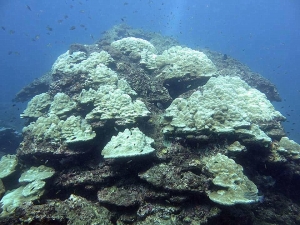Newsroom :: News :: Thailand unveils coral bleaching response plan amidst looming climate change threats
Thailand unveils coral bleaching response plan amidst looming climate change threats
Location: Bangkok, Thailand. 18th May 2016
Coral reefs, along with seagrass beds, mangrove forests and other tropical marine environments, are critical habitats that support the highest marine biodiversity in the world. They provide feeding, nursery and spawning grounds for a wide variety of marine life and protect the coastline from severe storms and rises in sea level. Over 500 million people worldwide depend on them for food, storm protection, jobs, and recreation.
Coral reefs are sensitive to small increases in ocean temperature and acidity, making them some of the most vulnerable ecosystem to climate change.
Thailand has been experiencing major coral bleaching events since 1991 with severe coral bleaching taking place in 1995, 1998 and 2010. This has left much of the pristine coral areas in the Andaman Sea in critical condition. While many of the reefs are well on the recovery trajectory, the current global bleaching event could further degrade the reef condition, ultimately affecting coastal community livelihoods as well as the tourism sector.
“In the past few weeks, the sea surface temperature has been ranging from 30-33 degrees C. This is significantly above Thailand’s coral reef threshold for bleaching at 30.5 degrees C. If the temperature remains the same, or rises, it is predicted that widespread bleaching will occur in up to 80% of coral reefs in the country,” said Dr. Pinsak Suraswadi, Director of the Marine and Coastal Resources Research Institute, DMCR.
DMCR has been monitoring the situation closely and began assessing coral reef resilience throughout Thailand based on the new guidelines jointly developed by Thai marine scientists and IUCN last November. DMCR scientists and DNP applied newly customized resilience indicators based on the standard protocol for coral reef assessment recommended by IUCN. The results will help to identify resilient and critical areas for protection.
The comprehensive response plan includes a dedicated coral bleaching warning system website to update about the situation around Thailand daily with real-time sea surface temperatures as well as an online reporting channel to gather critical information from various stakeholders on the ground.
“IUCN congratulates DMCR for developing a comprehensive and proactive management plan in response to the coral bleaching event. IUCN will continue to support the work carried out by the government of Thailand in minimizing the impact of this global event,” said Mr Petch Manopawitr, Deputy Head of IUCN Southeast Asia Group.
DMCR and IUCN have been partners in conservation since 2002, working on numerous projects, including Mangroves for the Future (MFF), Mangrove and Markets (MAM), Ecosystems Protecting Infrastructure and Communities (EPIC) and the Transboundary Dolphin Conservation project. Earlier this year, IUCN signed an MoU with DMCR to improve marine and coastal conservation in Thailand and to ensure that conservation and enforcement tools under the newly adopted Promotion of Marine and Coastal Resources Management Act are implemented for the benefits of coastal communities and ecosystems.
Temporary closure of reef areas
The coral bleaching response taskforce has proposed to close 32 sensitive reef areas temporarily to minimize human impacts and maximize protection of source areas = 15 of which are located in the Andaman Sea and 17 in the Gulf of Thailand.
These areas include famous diving sites such as the east coast of Mu Ko Similan National Park and Mu Ko Surin National Park in Phang Nga, Ko Yung and Ko Phai in Mu Ko Phi Phi National Park in Krabi, Ko Aew in Phuket and Ko Adang Rawi in Satun, Ko Talu in Prachuap Khiri Khan, and the northern part of Ko Pha-Ngan and Ko Samui in Surat Thani. The closure has been proposed for one year and further notice will be given after detailed monitoring has taken place.

Coral bleaching in Chumphon Province, Thailand © Watchara Samsuvan, Ramkhamhaeng University